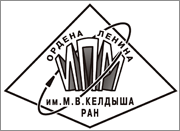|
Processes of microporosity formation at initial stage phase transition
G. I. Zmievskayaa, T. V. Levchenkob, G. Mainoc
a Keldysh Institute of Applied Mathematics, Russia
b All-Russian Research Geological Oil Institute, Russia
c Bologna University, Scuola di Lettere e Beni Culturali, Italy
Abstract:
Computer experiments of ions implantation can be applied to assess the porosity in
objects of cultural heritage. The pores appear under action natural and anthropogenic
factors of environment, the estimation can be made thanks to existence parameters
of similarity and processes periodicity accounting. The interaction of inert gas flux
of 5–10 keV ions energy with lattice of solid are discussed. Formation of porous
and stressed structures is about 10–100 msec. The initial (non-equilibrium) stage
of the phase transition is considered as the superposition of two random processes:
Clustering of gas monomers and their Brownian motion in crystal lattice of sample
consisting of several layers. At phase transition the clustering of nuclei appears in
result of the inert gas implantation into lattice in form of gaseous bubbles (blisters).
Kinetic equations for function the distribution of gas bubbles in the layers of SiC and
Mo, are replaced by equivalent SDE Ito–Stratonovich.
Keywords:
kinetic theory, stochastic simulation, porosity, silicon carbide, pore
clusters, self-organization, objects cultural heritage.
Citation:
G. I. Zmievskaya, T. V. Levchenko, G. Maino, “Processes of microporosity formation at initial stage phase transition”, Keldysh Institute preprints, 2019, 150, 24 pp.
Linking options:
https://www.mathnet.ru/eng/ipmp2788 https://www.mathnet.ru/eng/ipmp/y2019/p150
|

| Statistics & downloads: |
| Abstract page: | 86 | | Full-text PDF : | 147 | | References: | 12 |
|




 Contact us:
Contact us: Terms of Use
Terms of Use
 Registration to the website
Registration to the website Logotypes
Logotypes








 Citation in format
Citation in format 